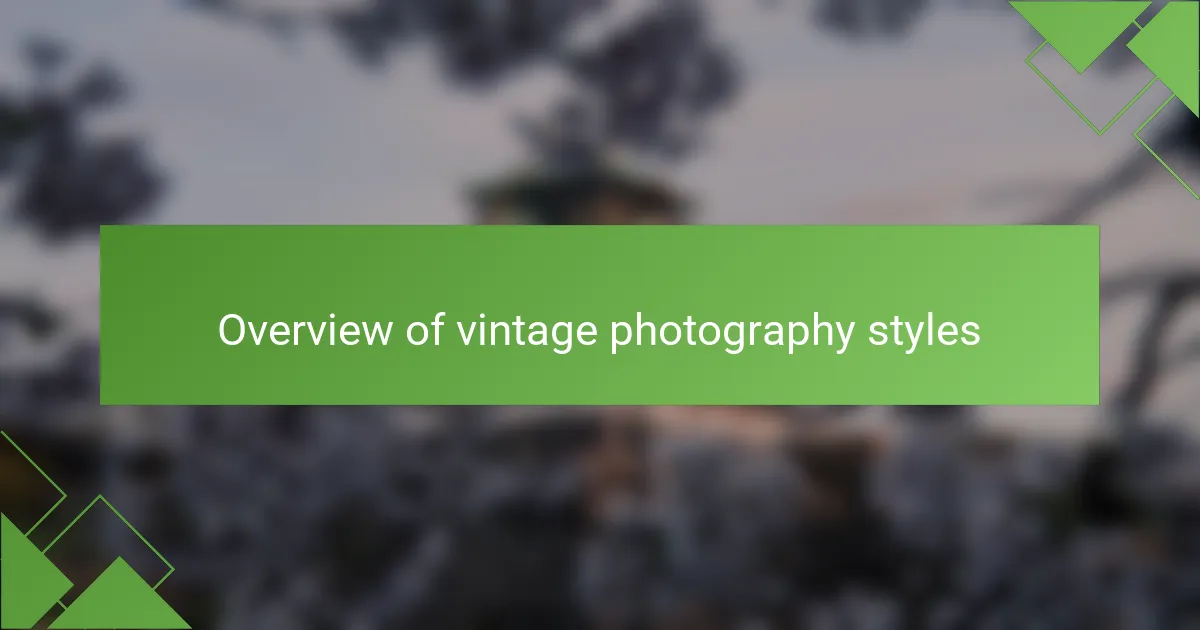Key takeaways
- Vintage filters enhance the emotional depth and storytelling of photography, evoking nostalgia and unique atmospheres.
- Each filter contributes a distinct aesthetic; styles like sepia, black-and-white, and film grain transform images into artworks.
- Using vintage filters simplifies editing and allows for creative exploration, encouraging photographers to experiment with light and tone.
- These filters create a connection to the past, enriching photographs with historical context and personal narratives.

Understanding vintage filters
Vintage filters have a unique charm that transforms ordinary scenes into evocative snapshots of the past. I still remember the first time I used a classic sepia filter while capturing the vibrant streets of Nice; it turned the lively colors into soft, nostalgic hues that seemed to whisper stories. Have you ever wondered how something as simple as a filter can evoke such strong emotions?
The magic lies in how these filters mimic the techniques and aesthetics of older film cameras. Each filter adds its own distinct touch, from soft vignettes to faded colors, creating an atmosphere that digital filters often miss. I’ve experienced this firsthand – one afternoon, as I shot the sunset over the Mediterranean, a vintage filter turned the golden light into something truly ethereal, lifting my spirits and evoking a sense of serenity.
What’s fascinating is how vintage filters can also enhance storytelling in photography. They can convey mood, nostalgia, or even a sense of longing with just a shift in tone. I often find myself asking: what story does this scene want to portray? By using vintage filters, I feel like I’m not just capturing an image, but capturing a moment steeped in history and emotion.

The role of filters in photography
Using filters in photography is much more than just altering an image; it’s about creating a mood and evoking feelings. I remember hiking along the Promenade des Anglais while experimenting with a soft-focus filter. It transformed the candid shots of laughing tourists into dreamy scenes that felt almost painterly. Have you ever seen an image that just pulled at your heartstrings? Filters can do that.
Filters also provide a way to manipulate light and color, which is essential in storytelling. I frequently play around with contrasting shades, and I find that a classic black-and-white filter can completely shift the narrative of a photograph. One moment, I was capturing the stunning architecture of an old French building, and the next, it felt like I was conveying the deep history and character in a more profound way.
Additionally, filters can bridge the gap between reality and imagination. They can let you explore various interpretations of a subject, allowing your creativity to flow. I once applied a grainy filter to capture the bustling atmosphere of a local market, and it reminded me of flicking through vintage postcards. Have you considered how a simple filter could invite viewers into your own creative vision?

Overview of vintage photography styles
Vintage photography styles have a unique charm that captures a moment in time, evoking nostalgia and warmth. My experience with these styles in Nice was truly enriching. The sun-drenched streets, with their vibrant hues, looked even more stunning through vintage filters, adding a dreamy quality that modern photography often lacks.
Each vintage style offers a distinct aesthetic, be it the muted tones of sepia or the soft glow of pastel colors. I remember one particular afternoon where I used a film-style filter that transformed a typical café scene into something reminiscent of a classic French film. It created a sense of intimacy and storytelling, which felt profoundly satisfying.
Here’s a comparison of popular vintage photography styles I’ve encountered:
| Style | Description |
|---|---|
| Sepia | Mimics the old, yellowish-brown tone of historic photographs, creating a warm, nostalgic feel. |
| Black and White | Emphasizes contrast and texture, ideal for dramatic scenes and classic portraits. |
| Polaroid | Provides a retro, instant photo look with soft edges and a uniquely imperfect finish. |
| Film Grain | Adds a textured appearance that brings warmth and character reminiscent of old film cameras. |

Benefits of using vintage filters
Using vintage filters in photography offers a unique way to infuse new life into your images. I remember wandering the vibrant streets of Nice, and the warm tones from a vintage filter made the sunshine seem even more golden, capturing the essence of that moment perfectly. It’s as if these filters allow you to translate your feelings into your photos, making every click of the shutter a little journey back to that specific emotion.
Moreover, vintage filters can evoke nostalgia and timelessness, creating an immediate connection with the viewer. I find that these effects can transform an ordinary scene into something extraordinary. It’s reminiscent of the old film days, which imbues my work with an artistic touch I truly cherish.
Benefits of Using Vintage Filters:
- Enhanced Character: Vintage filters add a unique flair that sets your photos apart.
- Emotional Depth: They evoke nostalgia, allowing viewers to feel the mood of the moment.
- Aesthetic Quality: The soft, muted tones can transform an average photo into an artistic masterpiece.
- Simplicity in Editing: Often, vintage filters require minimal adjustments, making the editing process quicker and more enjoyable.
- Timeless Appeal: They create a sense of timelessness, connecting your work with past photographic styles.

My personal journey with vintage filters
My journey with vintage filters began during a summer trip to Nice, where I first stumbled upon an old camera in a quaint second-hand shop. As I explored the charming streets and beautiful coastline, I felt a connection to the past; each click of the shutter transported me to a different era. The soft, nostalgic hue this filter added seemed to capture the essence of the French Riviera in a way nothing modern could.
Over time, I’ve learned to appreciate how vintage filters can evoke emotions and bring stories to life. The following points highlight my experiences and the influence these filters have had on my photography:
- Mood Enhancement: Vintage filters create a unique atmosphere that can transform even the simplest scenes into something magical.
- Historical Connection: I often feel a sense of connection to past photographers, as if I’m honoring their legacy with each shot.
- Experimentation: Using different filters allows me to play with light and color, leading to delightful surprises.
- Storytelling: Each photo taken with a vintage filter has a story behind it, making my portfolio not just a collection of images, but an emotional journey.
Reflecting on these experiences, I realize that vintage filters offer more than just aesthetics; they provide a window into a different time, enriching the stories my photographs tell.

Tips for using vintage filters
When using vintage filters, it’s important to consider the scene you are capturing. I remember standing on the Promenade des Anglais, with the azure waves crashing in the background. Applying a warm-toned filter not only accentuated the cozy atmosphere but allowed the golden hour light to dance across the frame. Have you ever noticed how the right filter can bring out the true essence of a moment?
Experimentation is key. I often try a variety of filters on the same subject to see how each one tells a different story. For instance, switching from a soft-focus to a sepia filter during a stroll through Old Town Nice made the cobblestone streets feel not just historic but enchanting. It’s fascinating how one filter can evoke an entirely different emotion—why limit yourself to just one perspective?
Lastly, don’t shy away from imperfections. Vintage filters often introduce a certain grain or texture, which can make your images feel rich and authentic. I once shot a charming little market scene and applied a grainy filter. The result looked like a snapshot from a cherished family album, filled with life and warmth. Isn’t that the beauty of photography? Each image can become a treasured memory, just like the ones we often hold close to our hearts.